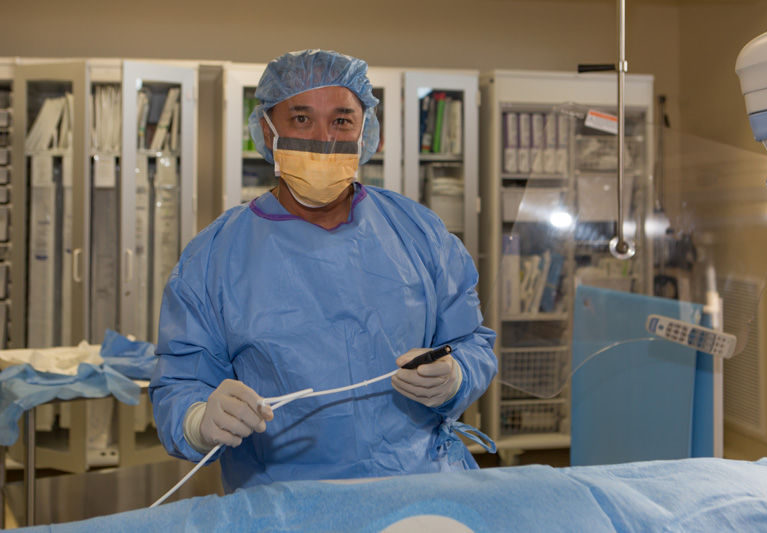
When introduced in 1895, the X-ray was a modern marvel. For the first time in history, physicians could see inside a living human body without having to cut it open.
That said, while early radiology was able to detect the presence of tumors as well as signs of many other diseases, it contributed relatively little to actually curing any of them.
Today that’s no longer the case. In the new field of “interventional radiology,” physicians use many other specialized tools besides radiation to not only see inside the body but also fix the problems they find.
Take, for example, the work of newly-arrived Dr. Hai Kenney, an interventional radiologist at Riverside Vascular & Interventional Radiology and the Sebastian River Medical Center.
Using infinitely more sophisticated imaging technology than the X-ray machine’s inventor, Dr. Wilhelm K. Roentgen, could have ever imagined, Kenney is able to treat and often cure diseases and conditions including lung, kidney and liver cancers, blockages in both the veins and the arteries, uterine fibrosis, compression fractures of the vertebra and a wide variety of other problems that used to require highly invasive surgical procedures.
In fact, the Cardiological and Interventional Radiological Society says Kenney’s chosen field of expertise “can be used in almost every organ system (in the body)” including the brain.
As a case in point, Kenney points out it was “the forefather of interventional radiology, Dr. Charles Dotter, who first pioneered the procedure known today as angioplasty.”
Angioplasty or “Percutaneous Coronary Intervention” uses a flexible, ultra-thin tube or catheter guided by remote imaging through the maze of blood vessels in the body. A small balloon inside the catheter is then inflated to open blocked arteries and restore normal blood flow.
Dotter, who was nominated for the Nobel Prize in 1978, did the first angioplasty on Jan.16, 1964. Today, some 50 years later, millions of people receive this life-saving, minimally invasive procedure each year.
Dr. Alan Matsumoto at the University of Virginia says, “Dotter’s work showed that with the use of imaging-guidance, you could employ cutting-edge technology to treat diseases without the cutting. Less became more.”
Angioplasties, however, are far from the only contributions interventional radiologic techniques are providing today. In fact, Stanford University calls IR “the surgery of the new millennium.”
Baltimore’s famed Johns Hopkins Medical Center, where Kenney worked for two years prior to arriving here on the Treasure Coast, explains in more detail: “The concept behind interventional radiology,” says Hopkins, “is to treat patients using the least invasive techniques currently available in order to minimize risk to the patient and improve health outcomes. These procedures have less risk, less pain and less recovery time compared to open surgery.”
“Interventional radiologists,” the Maryland medical institution continues, “are medical doctors with an additional six or seven years of specialized training after medical school.”
“For us,” explains Kenney, “minimally invasive means what we’re doing here is using a very, very small camera and we’re going into an artery. Everything is internal. We’re not cutting anything. … For example, we can treat a liver tumor by going into an artery in the groin, putting a catheter up directly into where the tumor is and directly delivering a chemo agent” to kill the tumor.
Imaging technology has improved exponentially in the 120 years since that first X-ray machine, and interventional radiologists now have modern fluoroscopy suites, ultrasound, computed tomography or CT scans and magnetic resonance imaging or MRIs along with updated X-ray technology to guide them through the human body.
“I think the way interventional radiology has expanded and grown has mainly been in response to the technology that’s available,” Kenney confirms. “It permits us to expand the procedures we already do and maybe even get into smaller vessels that we were unable to get into before.”
It might seem logical to expect some push-back from traditional surgeons as interventional radiologists continue to expand their fields of operation, but the buoyant and enthusiastic Kenney says that’s just not so.
“That’s the thing,” Kenney explains. “A lot of people think we become territorial and these specialists are fighting against us, but we don’t do that at all. We actually work in collaboration with these physicians whether they’re oncologists or surgeons. We work very closely together. The whole idea here is patient care. We work very closely with clinicians who have a treatment plan. We carry out the treatment and what we try to do is minimize the risk to the patient.”
The essential skills for an interventional radiologist include the ability to manipulate fine catheter tubes, wires and needles, and navigate anywhere within the human body while being guided by real-time video imaging. Few, if any, other medical specialties require this unique combination of skills, but in Kenney’s case, a desire to help patients keep their treatments close to family and friends might be an equally important facet.
“The whole idea of coming on board here,” Kenney says, “was to really keep everything in the community and not have to refer patients outside the community. If we can treat the patient here for cancer instead of sending them to Moffitt in Tampa, for example, it’s much better for the patient.”
Dr. Hai Kenney is with Riverside Vascular & Interventional Radiology at 7915 Bay Street in Sebastian. The phone number is 772-388-4370.



